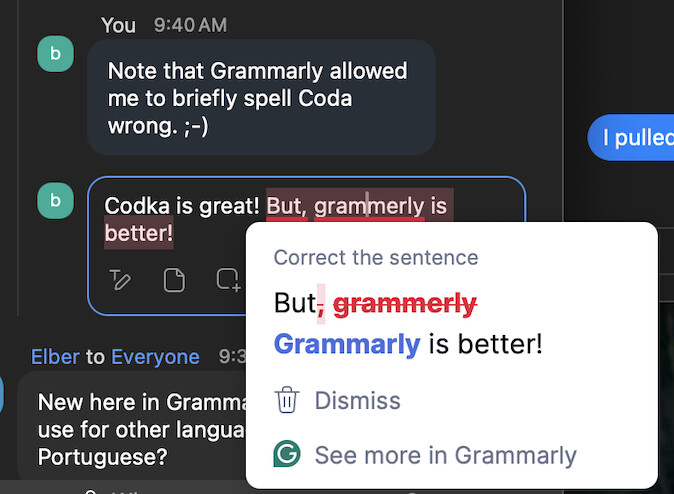Today, the Coda / Grammarly vision is even blurrier than I suspected.
I attended a Coda Meetup yesterday, and I was dismayed, to say the least. If I am misunderstanding what I saw yesterday, or I missed anything obvious, please correct me.
I was so bored by this meeting that I started to play with Grammarly in the shared chat. Ironically, I discovered Grammarly isn’t tuned with a bias toward ways to misspell Coda. [sigh]. Sure, this is petty, but it’s so easy to instrument AI to lean into certain brands, and they still haven’t even considered it.
A less petty realization occurred when I heard the term “app actions”. Unlike the Grammarly API, which is not what you might think it is, app actions provide seamless interchange of data between other apps and Grammarly. And by “seamless”, they mean you don’t have to interrupt your workflow to push or pull information from connected apps.
This is cool.
It wasn’t long ago that Grammarly deprecated its integration API designed to achieve similar capabilities. It was a few years ago when I first discovered this now-defunct integration API. With great hope, I began reading about App Actions, fully expecting to find a way to create action manifest files and build my own integrations with Coda or other systems. However, App Actions are proprietary and closed. You can’t make your own. Worse, there still isn’t one that connects any activities in Coda with Grammarly as was first envisioned in 2019, and later in my extensive write up here and another article (Smart Documents) in my Substack where I circle the Grammarly drain as it pertains to integrated AI in the canvas.
I also wrote about several integration approaches (From Your Lips to Coda’s Ears) that leveraged Grammarly and mentioned in Coda’s Future Demise.
Back to App Actions. I lay full blame for the product integration stasis on Grammarly.
Who builds an integration feature in 2025 that is not open and able to embrace user-defined interchange of information?
Perhaps the merger naysayers were right.
